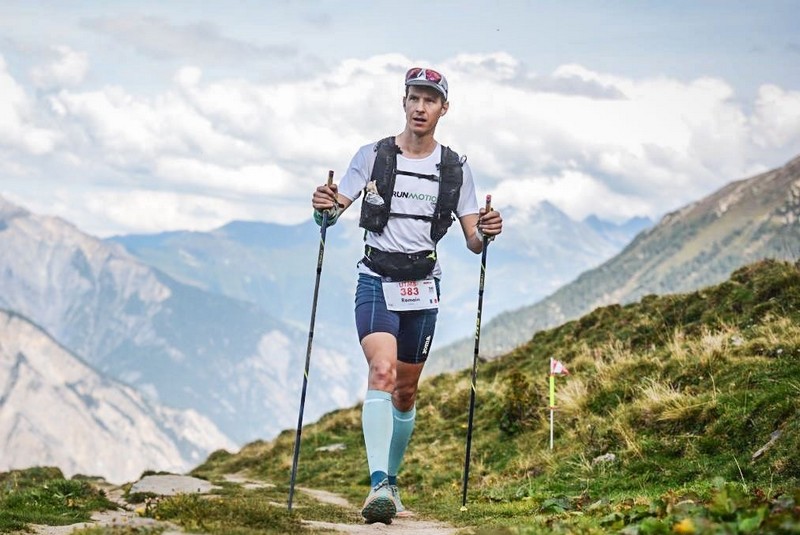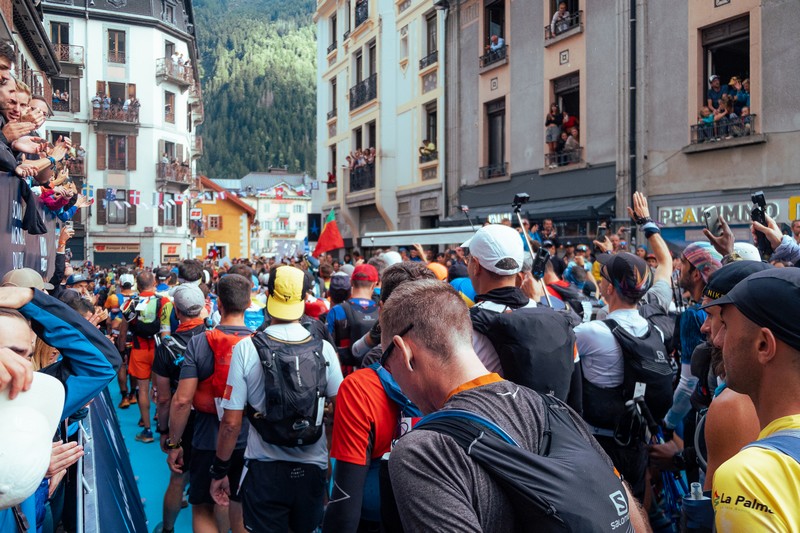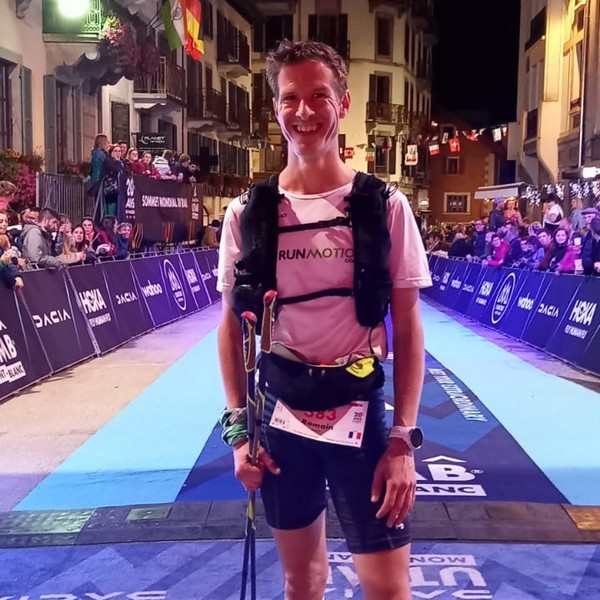
You are registered for the UTMB? And you’re wondering how to manage your effort on this extraordinary course and race? We will give you our advice to succeed in your race, whether you simply want to finish the UTMB, finish it in less than 40 hours, or even less than 30 hours. We won’t discuss the management for the champions, they already have their coach 😉
For my part, I experienced 2 diametrically opposite experiences. The first one, a DNF in 2022 due to knee pain from km20 to Champex at km130. The second one, in 2023, floating on cloud nine by finishing the UTMB in 29h24 thanks to the experience gained. So I will try to give you the keys to succeed in the UTMB!
Contents
The UTMB start in Chamonix
The start is already a condensed emotion. The streets of Chamonix are packed to the brim. The starting gates open about 1 hour before the fateful hour. If you’re aiming for a good time, it’s best not to be late so you’re not too far back at the start. Otherwise, stay in the second half so you don’t get carried away.
The wait at the start is long, often in full sun, so make sure to wear a cap (or something to cover yourself if it rains) to not lose energy. Stay seated for as long as possible. You can arrive jogging 5 minutes but you will cool down so there’s no need to warm up extensively before.
The adrenaline rises as 6 PM approaches. There are two schools of thought: those who are overwhelmed by emotion, reminiscing about all the sacrifices in training and thinking about their loved ones. And those who try to remain focused. In any case, these memories will remain etched in your mind.
The music Conquest of Paradise by Vangelis resonates in Place du Triangle de l’Amitié at the starting area!
The UTMB is oooooon!!!
The race starts! The streets are filled with people and the encouragement is magical! Everyone can enjoy the cheers and enthusiasm of the Chamonix city. Caution!! There’s no need to start at 15km/h, there are still 171km to go, you have to consider that the first 10 kilometers are just a warm-up. We absolutely stay in fundamental endurance, with maximum ease.

The first 10 kilometers of the UTMB to Les Houches are relatively flat, so save as much energy as possible, gaining 5 minutes (30’’ per kilometer) is completely useless compared to the duration of the effort.
The climb to Col de Voza
The atmosphere on the early slopes of Col de Voza is akin to the Tour de France! Guaranteed atmosphere! Be sure to remain very easy, it’s the first climb, stretch out your legs well. It’s already worth taking out the poles to save your thighs as much as possible. Don’t listen to the supporters who tell you “go for it!”
The climb to Col de Voza is steep at times. Remain as relaxed as possible.
The descent to Saint-Gervais
Be careful with this first descent. A path descends straight down a ski slope with the steepest slopes of the UTMB! Save yourself as much as possible and stay focused to avoid immediately tearing too many muscle fibers in the first descent.
There’s a bit of variety with forest paths, but the descent to the center of Saint-Gervais is steep almost the entire way. During my first UTMB, I started to feel knee pain at the end of the descent, which handicapped me for the rest of the race.
In any case, gaining or losing 5 minutes in this descent is absolutely negligible in the duration of the race. You must absolutely not push yourself too hard.
The light is starting to fade, but most runners don’t put on their headlamp until the Saint-Gervais aid station.
From Saint-Gervais to Contamines-Montjoie
In Saint-Gervais, fill up your water bottles, you can eat a bit but don’t stay too long at the aid station. The atmosphere in the streets of Saint-Gervais is excellent and it feels good to get going again after the long descent.
The paths to Contamines are hilly and quite playful. You may feel like picking up the pace but it’s too early in the race. Stay cautious and watch out for roots as it’s the first sections of the night and there are sometimes roots.
Col du Bonhomme – Chapieux
The passage at Notre-Dame-de-la-Gorge is a last moment of effervescence, the climb up the Voie Romaine is worthy of a Tour de France climb! It’s the end of civilization before Courmayeur. It’s starting to get pitch dark. You have to consider that it’s the beginning of the night, and you have to save your strength to fight against the elements and night fatigue. The climb to Col du Bonhomme can be very windy. Still, be careful not to cover yourself too much.
The hardest part of this section is the descent to Chapieux, very steep and sometimes slippery. It’s best not to strain your thighs too much at this stage of the UTMB. When arriving at Chapieux, it’s better to eat something warm to cope with the cold night ahead.
Chapieux – Lac Combal – Courmayeur
The climb to Col de la Seigne is in two parts. A first undulating section to the Mottets refuge and then a steep climb. The peak reaches 2500m, it’s late at night, it’s often cold, and you may experience some nausea (I remember seeing runners vomit at the top). This is often where the first setbacks occur if you started too fast. Try to control your heart rate.
Once over the col, you cross into Italy. The descent is short. You quickly climb back up to the left to the limestone pyramids. It’s very technical, on protruding stones. It’s hard to accelerate on this section, even when going downhill. Above all, avoid getting injured. Arriving at Lac Combal gives a taste of Italy, with an aid station, you’ll soon be in Courmayeur.
The climb to the Mont Favre Ridge, before Courmayeur, is steep but not too long. The descent to Courmayeur, on the other hand, is very steep. Fortunately, it’s fairly short, but you’ll be glad you did a lot of strength and general physical preparation! Otherwise, you may already be in trouble…
Courmayeur: The UTMB truly begins!
Here we are, almost halfway through the UTMB! It’s the first major aid station. Most trail runners stop for 20 to 40 minutes. It’s for many the first real refueling after sunrise. Better refuel! You need to replenish your carbohydrates and hydrate well. Mentally, the new day and the halfway mark mean that the UTMB truly starts here!
Courmayeur – Refuge Bertone – Grand Col Ferret
You can leave Courmayeur slowly to digest well. You will especially need to be able to pick up the pace as soon as you reach Refuge Bertone. Indeed, the path flattens out and there are 13 km rather easy where you can save time by running up to the foot of Grand Col Ferret.
The climb to Grand Col Ferret is formidable, it’s steep, often in full sun. You need to be patient during this climb, in order to regain momentum on the descent.
La Fouly – Champex Lac
At the border between Switzerland and Italy, at Grand Col Ferret, the descent is long, almost 20 km! You mustn’t “let the horses loose”! You should run as much as possible, but while preserving your thighs because the more you run, the more time you gain. If you go 2 km/h too fast, you risk having to walk a long time to recover.
The more you can run to La Fouly, the better! The aid station at La Fouly is important, you should take it, but don’t linger too long. Runners usually prefer to refuel for a longer period at Champex-Lac. If you feel good, the section between La Fouly and Champex-Lac goes by quickly. If you’re not feeling well, you need to endure and reassess at Champex. Family and friends are allowed at the Champex aid station, it can do wonders! At this point, you start to hurt everywhere!
Champex-Lac – Vallorcine
Leaving Champex, you have to cover 4-5 kilometers before facing a tough climb before La Giète! It’s not very long but very steep. You have no choice but to move forward! Then the descent to Trient is quite steep and full of roots. Stay focused. Relax your thighs as much as possible.
Trient and its pink church are an opportunity to replenish your energy before one of the steepest climbs of the UTMB course. Like the previous one, fortunately, the climb doesn’t exceed 600m of positive elevation… The descent to Vallorcine is still quite technical. Indeed, from Champex onwards, the kilometers don’t seem to pass quickly!
Vallorcine – Chamonix
Vallorcine is the last real aid station of the UTMB (there is a light aid station at La Flégère) before reaching the long-awaited finish in Chamonix. When you’re there, only an injury will prevent you from reaching the finish line! In 2023, a variant of the UTMB course (usually passing by Tête au Vent), far from being a gift, technically challenging, had nothing to envy of the original course. Once you’ve reached La Flégère, you must manage the final descent of the UTMB.
In this descent, you see everything. Those who rush down, those who limp, those who secure the last descent, those who wander like zombies!

Here you are arriving in Chamonix! I won’t describe the UTMB finish, everyone experiences it differently. I sincerely hope you get to experience it yourself! I hope this article will help you manage your UTMB well.
There will be tough moments. It’s unavoidable in an ultra trail. But knowing the UTMB course, via this article, or through a 3-4 day UTMB reconnaissance is a big plus.
You can tell us about your adventure here, especially if you’ve prepared with RunMotion Coach, the personalized trail training application, with a very useful general physical preparation module for ultra trails!